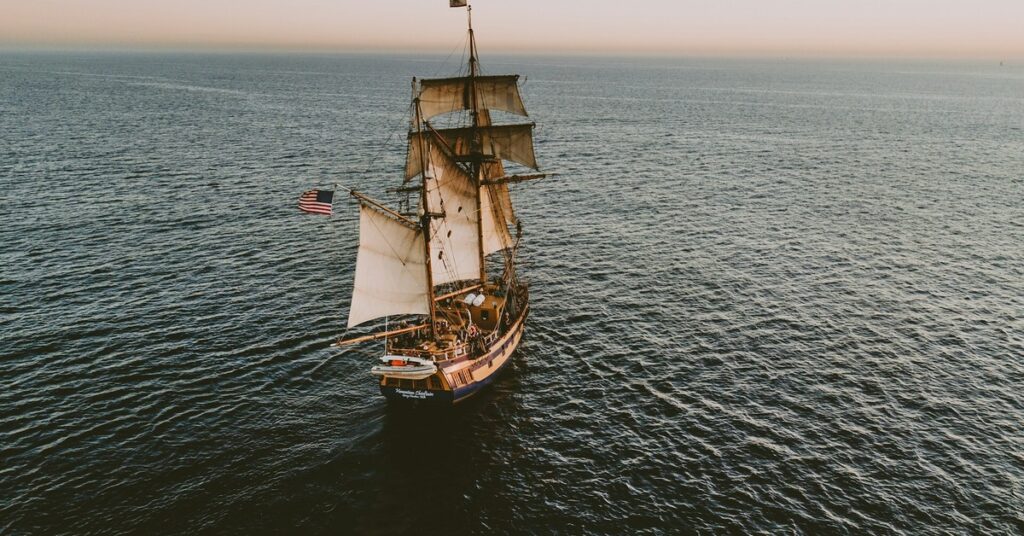Ships have been integral to human civilizations for centuries, dating back to Ancient Egypt. Wood was the preferred building material for boat construction because of its accessibility and durability. While shipbuilders have switched to other practices, wood still has a place in the maritime industry. The numerous types available mean manufacturers have myriad options, so here’s a guide on shipbuilding woods.

What Are the Most Common Shipbuilding Woods?
Shipbuilders worldwide have depended on wood for centuries, and the type of wood needed varies depending on locality, infrastructure and preference. Here are the eight most common woods on vessels.
Teak
Teak is one of the best woods for shipbuilding because of its durability. Native to South Asia, teak trees grow in hardwood forests and are famous for their leathery smell. Experts say most of the world’s teakwood comes from India, with 66,000 annual shipments to the U.S., U.K. and other nations. However, you can also find exports from African and Caribbean nations because of cultivation in these areas.
Shipbuilders use teakwood because of its excellent tensile strength and durability. A 2022 Materials Today study finds teakwood has a tensile strength of 71.15 megapascals, demonstrating its natural strength. Additionally, teakwood is easy to process and a sustainable choice for shipbuilders.
Boats get daily exposure to sunshine and saltwater, and teak better resists corrosion than other woods. Crews on teakwood boats don’t worry as much about rotting or damage from insects, so it has been a prominent choice for centuries. Traditional boats in Indonesia and other locations still use teakwood because of its availability.
Mahogany
Teakwood can be expensive for shipbuilders due to high demand and relatively low supply. Its low availability makes mahogany a natural alternative. This wood type is common in ships, furniture and other use cases because it’s lightweight and relatively inexpensive. A 2021 IOP Science study examined laminated mahogany’s quality compared to teakwood and says it meets the minimum tensile and bending strength requirements. Therefore, fishing vessels can use mahogany for boat construction.
Mahogany is a popular choice for ocean vessels because it can withstand the antiseptic conditions of saltwater. This wood demonstrates durability by not shrinking or warping despite the surrounding conditions. However, freshwater bodies are not optimal for mahogany because they lead to rotting and decaying once the water permeates it.
Balau
Another teakwood alternative comes from balau — a wood native to Southeast Asia. Like teakwood, balau grows in India, Indonesia, Malaysia and other countries in the region. While wood is not as prominent in modern ships, balau is still a standard shipbuilding source for locals needing transportation in coastal areas between islands. A 2020 IOP Science study finds balau — along with Kupang, teruntum and others — are viable teakwood alternatives for shipbuilding.
Balau is a prominent wood in ships because of its density and durability. Ships made from balau are typically strong, helping them withstand strong sea forces. Boat construction often uses balau for cladding, footbridges and decking, regardless of the color of the wood the manufacturer uses. While practical, balau wood brings disadvantages like toxicity for some users and vulnerability to insect attacks.
Oak
Oak has a long history in shipbuilding woods, as nations have used it for trade, wars, exploration and other critical uses. This hardwood was popular during the age of exploration because its planks could support the ship’s hull and reinforce sheathing made from weaker woods. Warships significantly benefited from oak because they allowed militaries to maintain boats in battle.
While less prevalent now, oak still has a role in modern shipbuilding. For example, the U.S. Navy owns a white oak forest in Indiana to repair its antique ships in various museums and historical vessels. Restoring ships with oak helps maintain their structural integrity because of the wood’s strength.
Oak combines the best qualities of other hardwoods by demonstrating strength, insect resistance, density and durability. However, there are downsides to using this type of wood. Oak is expensive and less available than other options, and its density makes it more challenging to craft when building ships. This hardwood is still functional when crafting small boats or decks on larger ships, and high-end vessels may use it for interior design like cabinetry.
Cedar
Cedar is another timeless and reliable material for the shipbuilding industry. This wood is unique because it’s soft, but that lightweight nature has made it prominent for centuries, with historical texts referencing cedar from Lebanon in ancient ships. For instance, the Uluburun shipwreck in the 14th century B.C.E. used Lebanese cedar to haul precious metals but sank near present-day Southwest Turkey.
Another supporting feature of cedar is its ability to resist rotting and insect damage. It has long been famous for its pleasant scents, which comes from its natural resin. This sealant protects cedar in the ocean, making it a durable choice for crews.
Nowadays, cedar is most common in recreational paddle craft like kayaks and canoes, but maritime professionals still use it for trims and accents on modern ships. Traditional watercraft like punt boats still use cedar because they’re lightweight and easy for the operators to maneuver.

Pine
While hardwood gets more attention for its strength, softwood constitutes a significant chunk of the lumber industry. Experts say it accounts for 70% of all timber production, meaning it’s about four times as prevalent as hardwood. Pine is another softwood used in shipbuilding — a genus found on nearly every continent.
Pinewood is inexpensive and easy to work with, making it an accessible option in ship construction. This selection is among the strongest in the softwood family, but it’s not as common as oak and other hardwoods. While it was prevalent in early shipbuilding, pine was tricky to work with because of its susceptibility to rot. Factors like suboptimal soil moisture make pine trees rot faster, making them a liability in seafaring vessels.
While also prevalent in skincare and baseball, shipbuilding has long used pine tar because it conserves wood, binds materials, aids in waterproofing, has antibacterial properties and seals gaps in a vessel’s hull to reduce the chances of leaks on the ocean. Owners also use pine tar to safeguard their boats from rotting because it’s sticky and protects them from marine life.
Douglas Fir
Mentioning a Douglas fir may conjure images of Christmas trees, but this member of the pine family is a solid shipbuilding material. Native to the Pacific Northwest, Douglas firs are a strong softwood fit for boats because of their versatility. Builders can leverage the wood’s durability because research shows its mechanical properties remain intact despite exposure to temperatures over 280° Celsius.
Douglas firs remain relevant in shipbuilding when constructing masts or spars. Wind can negatively impact a ship’s hull and threaten its buoyancy, so strong materials like Douglas firs are necessary when constructing masts. This softwood has straight grains and stiffness to weather storms, making it ideal for these parts of ships.
Marine-Grade Plywood
Plywood remains a standard choice in boat construction — shipbuilders use marine-grade BS 1088, BS 6566 and AS/NZ 2272. These materials are readily available, as plywood is typically less expensive and arduous in production than hardwood. When using plywood, operators may find Douglas fir or western larch bonded with adhesives like weather boil proof.
Ship owners also use marine-grade plywood for water resistance. The strong iteration of this wood also boasts uniform strength throughout to keep vessels afloat. While there are pros, shipbuilders must be aware of the cons. For example, marine-grade plywood can react to chemicals and won’t completely protect a boat from water. Constructors must also consider how it bends when too much weight is on it.
What Is Wood’s Role in Modern Ships?
Seeing ships made entirely of wood is less common because of improved shipbuilding practices. However, hardwood and softwood still play a role in modern boat construction. Here are a few ways modern shipbuilding woods support vessels.
Carbon Fiber
While wood isn’t as relevant, other materials can reinforce it and make ships viable for the seas. For example, carbon fiber is strong and highly resilient while remaining relatively thin. Therefore, weaving it around the material used in shipbuilding makes it stronger.
Carbon fiber reinforcement makes vessels look more authentic while supporting structural integrity. Castagnola Yacht — an Italian shipyard — produces yachts with carbon fiber that show off a black hull.
Decks
A common area to see wood on modern ships is the deck. While some have converted to steel, some decks still contain wood for practical and aesthetic purposes. For example, a teakwood deck would be sensible because it resists rot and insect damage better than most hardwoods.
Regardless of the wood selection, decks benefit from non-slip deck paint for extra safety. A crew might apply Durabak marine liner because it bonds well with wood to prevent slips.
Interior Design
Wood won’t hold up as well as fiberglass or steel for exterior surfaces, but it’s still viable for interior design. Shipbuilders often use wood for cabinetry and hardwood for aesthetics and practicality. The different types offer light and dark shades depending on the operator’s preferences. Well-treated wood can last long in a ship’s interior and be flexible for nearly any use.
Fuel
Making ships more sustainable is a priority for the maritime industry, so all options for reducing emissions are on the table. How can ship operators make their vessels more environmentally friendly? Wood mass feedstock is one strategy for alternative fuels, as it is more sustainable and less expensive than traditional fossil fuels. Oak, maple and other hardwoods are excellent examples used for more bio-friendly power.
Frequently Asked Questions
Do ships still use wood?
Most shipbuilders evolved to steel and fiberglass because they have superior insulation and are more durable. However, you can still find wood in various components of ships, such as the deck.
Where can you find wooden ships?
Most wooden ships are in museums and historical sites. For example, the U.S.S. Constitution in Boston is among the few still in commission.
Is hardwood or softwood better for boats?
Hardwood is generally better because it’s stronger and more durable than softwood. However, softwood holds its own if the operator needs a lighter, more maneuverable wood.
How do shipbuilding woods prevent water damage?
Wooden ships use tar on the hull to mitigate water exposure as much as possible. This material seals planks together and improves the boat’s buoyancy.
What is the largest wooden ship?
The largest wooden ship title belongs to the Wyoming — a 450-foot-long schooner built in Maine. This ship lasted about 15 years before sinking in 1924.
- The 15 Most Exciting New Ships of 2025 – January 6, 2025
- How Old Do You Have to Be to Drive a Boat? – November 12, 2024
- The Engineering Behind Ice-Class Vessels – September 20, 2024



